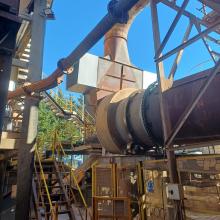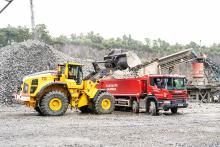
Concrete is the world’s most widely used material after water, and cement is an essential part of the global economy - critical to buildings, transportation, and other infrastructure. The sector generates 8% of global CO2 emissions, more than aviation and shipping combined. The challenge of increasing emissions is becoming more urgent as concrete and cement production is increasing to meet global needs. Without efficiency gains, demand for cement is projected to increase by 50% by 2050.
- 22% emissions reduction can be achieved on the demand side through efficiency improvements in construction and design reducing the volume of concrete needed without compromising safety or durability.
- 25% reduction can be achieved in process emissions on the supply side by deploying Supplementary Cementing Materials (SCMs) to decrease the use of clinker; whilst bringing alternative chemistries to commercial stage.
- 53% of emissions can be reduced, eliminated or captured through a combination of fuel switch, power sector decarbonisation and carbon capture utilisation and storage (CCUS).
CCUS currently has the largest emissions-saving potential of all available technologies, and 33-45 new CCUS plants with an annual capacity of 80 megatonnes (Mt) of CO2 must be in operation by 2030 for the industry to stay within its carbon budget. However, new data from MPP’s tracking of green industrial projects – released by MPP for COP28 – shows that the current pipeline falls short as projects struggle to reach FID. Fifteen plants have so far reached this critical point.
MPP calls for immediate action across the concrete production value chain from industry, governments and financial institutions worldwide to create an enabling environment for innovation and decarbonisation. Its roadmap details actions needed in the short and long term to rapidly decarbonise the sector.
Near-term milestones
By 2025:
- Governments permitting increased use of SCMs and using procurement power to bring about deployment
- Concrete demand reduces by 4% compared with business-as-usual
- CO₂ transport and storage plans in place and construction started across three regions
By 2030:
- 33-45 commercial-scale carbon capture plants to be operational
- Concrete demand peaks and starts decreasing globally
- Global average clinker-binder ratio drops to a global average of 0.54-0.58 from 0.63 today.
By 2035:
- 35% reduction in emissions achieved if previous milestones are met
Mission Possible Partnership CEO, Faustine Delasalle, says: “Our report sets out precisely what needs to happen to make zero carbon concrete and cement a reality, but time is not on our side. The moment to roll up our sleeves and work together across the value chain and with governments is now. Immediate collaboration and cooperation – from producers through design and construction – together with policymakers and finance – is essential to making the necessary progress this decade.
Collective acknowledgement of the strategy, from a wide variety of companies and the largest in the concrete and cement sector, reflects the growing momentum of business for action in the near term. Making Net-Zero Concrete and Cement Possible joins a series of industry transition strategies backed by 200+ industry players and developed by MPP to guide the decarbonisation of seven hardest-to-abate sectors.
Quotes from acknowledgers:
“At Argos, we are committed to making possible the construction of housing and infrastructure dreams to enable a more sustainable, prosperous, and inclusive society. That is why we are conscious of the importance of reaching net zero by 2050 while the countries where we operate keep developing.” – Juan Esteban Calle, CEO, Cementos Argos
“The concrete and cement transition strategy is a relevant user-friendly guide towards the decarbonisation needed around the world, as it clearly describes the general global actions that need to be taken to achieve carbon neutrality in 2050. However, there is still a pressing need to dive deeper into regional and local insights and differences in mitigation, adaptation and opportunities, and the regional and country roadmaps especially within developing countries, since cement and concrete are essential for the achievement of sustained economic growth and the eradication of poverty and to mitigate the effects of climate change; therefore a successful implementation will need to reconcile this reality with appropriate public policies that take into account local challenges and needs, and the economic cooperation of economies that have already developed.” – Javier Durand, Cementos Pacasmayo S.A.A.
“We at Misr Cement Group are proud to be an active member within the Global Cement and Concrete Association (GCCA), as we are considered one of the first Egyptian local companies to commit to supporting the global sustainable economic, social and environmental development priorities” – Eng. Bassam Abd Elrassoul, Acting CEO, Misr Group.

“We welcome all organisations and efforts to decarbonise the cement industry, and we support the main conclusion of the STS report that Net Zero transition is possible. There is much to be done on the road to Net Zero, and we need the collaboration of public and private sector to achieve the regulatory changes necessary to accelerate the transition.” – Fernando A. Gonzalez, CEO of Cemex.
“At Holcim, we are at the forefront of decarbonising buildings across their entire lifecycle to build better with less, from our operations to low carbon construction to energy-efficient buildings in use. The MPP sector transition strategies provide a pathway showcasing how companies and policymakers can collaborate to accelerate decarbonisation” – Miljan Gutovic, Holcim Region Head Europe.
“A perfect all-in-one report. Especially the key message on the very limited cost impact of using zero-carbon concrete on overall cost of construction should be advocated worldwide.” – Jan Hoppenbrouwers, CCO & Investor Relations, CarbonOrO.
“Secil is fully aligned with and committed to the pathway of decarbonisation of the cement and concrete industries. We know our challenges and responsibilities. We are addressing them through our comprehensive decarbonisation roadmap together with our stakeholders.” – Otmar Hübscher, CEO, Secil.
“This report recognizes the substantial role that those responsible for designing and constructing the built environment play as demand-side partners in significantly reducing the GHG emissions of concrete and cement through thoughtful design, efficient use and reuse, specification and carbon sequestration.” – Vincent Martinez, President and COO, Architecture 2030.
“As an OEM equipment supplier to the cement industry with a tradition of more than 160 years of innovation, the decarbonisation of the cement industry is the focus of our activities. We consider it our obligation to develop solutions for the biggest challenge in our industry. Our machines and plants allow for substantial carbon reduction already today and will provide cost-efficient carbon capture through oxyfuel and other novel technologies for total decarbonization.” – Matthias Mersmann, Chief Technology Officer (CTO), KHD.

“It is important that we all work together to implement strategies to decarbonize cement and concrete at scale. Most notable to us at the Carbon Leadership Forum is the high impact of strategies under the control of building owners, designers, engineers, and builders. Focusing on efficient use of concrete and optimisation of concrete mixtures can be cost-saving strategies that are easy to implement today.” – Kate Simonen, Executive Director, and Jordan Palmeri, Senior Researcher, Carbon Leadership Forum.
“Heidelberg Materials welcomes the MPP’s Transition Strategy for Cement and Concrete, which builds on the industry’s existing and robust decarbonisation roadmap towards 2050. It emphasises the need for strong collaboration of all actors along our value chain and underscores the essential policy levers that are crucial for assisting us on our path to achieving net-zero emissions,” – Dr. Dominik von Achten, CEO Heidelberg Materials AG and Chairman MPP Concrete Action for Climate.










